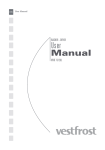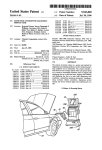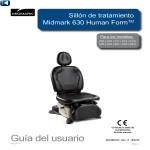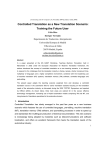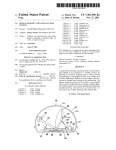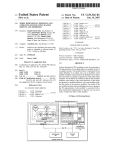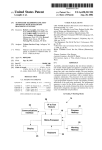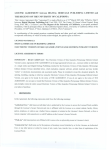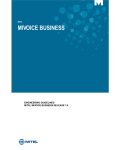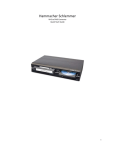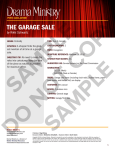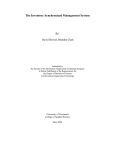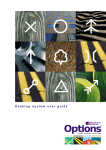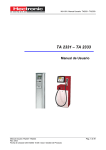Download @IEEWEIE
Transcript
US007028259B1 (12) United States Patent (10) Patent N0.: (45) Date of Patent: Jacobson (54) INTERACTIVE LEGAL CITATION US 7,028,259 B1 Apr. 11, 2006 Brochure: CiteRiteTM For Windows®iFeatures Bene?ts, Lexis’ Nexis, 2 pgs., not dated. CHECKER Website Print-Out: CiteRiteTMII, Lexis’ Nexis, 3 pgs., (76) Inventor: Robert L. Jacobson, 1414 Laurel Ave., Apt. L301, Minneapolis, MN (US) 55403 (*) Notice: Subject to any disclaimer, the term of this patent is extended or adjusted under 35 U.S.C. 154(b) by 706 days. Feb. 1, 2001 Related US. Application Data Brochure: Add New Dimension to Your Documents with (60) Provisional application No. 60/179,572, ?led on Feb. 1, 2000. (51) Int. Cl. G06F 17/24 WestCiteLinkTM 3.0, West Group, 4 pgs., Copyright 2001. (Continued) (2006.01) (52) US. Cl. .................................................... .. (58) Field of Classi?cation Search .............. .. 715/540, 715/531 715/530; 706/12 See application ?le for complete search history. (56) Nexis, 12 pgs., Jan. 18, 2001. Website Print-Out: CiteltliLegal Citation Made Simple!, Sidebar Software, Inc., 8 pgs., Copyright 1997-2001. Cite-It/- Legal Citation Made Simple, User Manual, Sidebar Software, Inc., 74 pgs., Copyright 1997-2000. Website Print-Out: WestCiteLinkTM Overview, West Group, 38 pgs., Copyright 2001. (21) Appl. No.: 09/775,184 (22) Filed: Copyright 1999. Website Print-Out: CiteRiteTMII, Product Description, Lexis’ Nexis, 2 pgs., Copyright 2001. Sample CiteRite Report, Lexis’ Nexis, 10 pgs., not dated. Website Print-Out: CompareRite Sample Printe, Lexis’ Primary ExamineriHeather R. Herndon Assistant ExamineriDoug Hutton (74) Attorney, Agent, or FirmiPatterson, Thuente, Skaar & Christensen, P.A. (57) ABSTRACT References Cited U.S. PATENT DOCUMENTS 5,608,625 A * 6,502,081 B1* 3/1997 Bailey ...................... .. 715/540 12/2002 Wiltshire et a1. ........... .. 706/12 OTHER PUBLICATIONS Supnik, Paul D., “Getting Your Cites in Order” Los Angeles Lawyer Magazine (Jun. 1989).* WestCiteLink FAQ, at http://www.westlaw.com/citelink/ faq.wl (@ 2003).* LexisNexis Citation Tools 2003, at http://support.lexisnexis. com/CitationTools2003/record. asp?ArticleID:CitationTolls2003idefault&Print1 2005).* A software utility scans a word processing document to locate citations to court opinions. It parses each citation to determine its constituent elements, such as the citation’s case name, the reporters in which it is published, its juris diction and court, and its date. It then compares the citation as it is written against stylistic rules for legal citations. If it ?nds a deviation from one of the stylistic rules, it displays a message to inform the user of the error and, if possible, suggests speci?c changes to correct the error. If the user accepts one of the corrections, the utility makes that change to the word processing document. (@ 52 Claims, 10 Drawing Sheets @Samnla - Microsoft we": file Edil 118W insert Fgrmat lauls Tabla Mildew Help deposition testimony to manufacture an issue of material fact, it may offer an affidavit that 50 expands upon, explains, or clari?es prior testimony. See Leslie v. Grupo ICA 198 F.3d 1152, 1157 (9th Cir. 1999); Messick v. Horizon Indus. Inc. 62 F.3d 1227, 1231 (9th Cir. 1995);% v. Cutter Biolo ieal In 953 F1“ 262166-67 (gl‘fee Leslie v. Grugo ICA 199 Fan 1152, 1157 (9th Cit. 1999) I two days of depositio _ Suggestion ‘Fee Leslie v. Gtugo ICA 198 F3d1152, 1157 (9th Cir. 1999) 56 I Federal Reporter should be abbreviated as "F.3d_. Change "F3d" to "F.3d"? @IEEWEIE Table T.1: United States .Iurlsdlctions, Federal Courts atAppeals (eg. 2d on. 0.0.. Cir). previously Circuit Courts of Appeals (9.9 2d Cir), and Court 01 Appeals oillortha District at Columbia (D.C. Cir): Cite to F.. F2d. or F.3d. ’\ Federal Reporter Page 1 Sec 1 18914319 F., F.2d, F 3d US 7,028,259 B1 Page 2 Brochure: Drafting with Deal Proof Team, expeitEaseTM OTHER PUBLICATIONS Website Print-Out: Getting Your Cites in Order, Paul D. Supnik, 5 pgs., Sep. 27, 2000. Website Print-Out: Buyer’s Guide to Corel WordPerfect Legal Suite, Thomas L. Rowe, 4 pgs., Copyright 1998. Website Print-Out: CiteRiteTM 5.5 and 7.0, review, Law Software, 2 pgs., not dated. Brochure: Deal Proof 3.0, expeitEaseTM Software, 14 pgs., not dated. Website Print-Out: Deal Proof Tech Requirements, expeitEaseTM Software, 1 pg., Aug. 3, 2001. Of?ce Computing Magazine, 1 pg., Aug. 31, 2000. expertEaseTM Website expeitEaseTM Software, 2 pgs., Copyright 1999-2001. Website Print-Out: Legal Citation-overview, Oberon Development, 1 pg., Copyright 1998-2001. Print-Out: Law Of?ce Software, BlumbergEXcelsior, Inc., 2 pgs., Copyright 2000. Manual: Using WestCheck® Version 3.2 for Windows®, West Group, 18 pgs., Copyright 1999. Brochure: CheckCiteTM 2000, Quick Reference, Lexis’ Nexis, 1 pg., Copyright 1999. Website Print-Out: expertEaseTM Software, complete overview, 33 pgs., Aug. 3, 2001. Website Print-Out: Complex Document Proo?ng, LexTech Inc., 2 pgs., Aug. 3, 2001. Website Print-Out: Entrepreneurs Invading Israel to Find Fortunes, Jessica Steinberg, Forward, 3 pgs., Copyright 1998. Website Print-Out: Three Products to Watch Summer 1998, Mark Rambler, Law Of?ce Technology Review, 2 pgs., Copyright 1998. Website Print-Out: Beyond Spell Check Aug./Sep. 1998, Richard Belthoif, Law Office Computing MagaZine, 2 pgs., Copyright 1998. Website Print-Out: The Electronic Lawyer, Alan Pearlman, Legal Tech Newsletter, 2 pgs., Copyright 1998. Website Print-Out: Avoiding Silly Drafting Errors with Deal Proof, Barry Bayer, Benjamin H. Cohen, Law O?ice Technology Review, 3 pgs., Copyright 1998. Website Print-Out: Across Our Desk, Bruce Brumberg, National Association of Stock Plan Professionals, vol. 6, No. 1, Mar. 1998. Software, Technology White Paper, Website Print-Out: Legal Citation-Introduction to the Basics, Oberon Development, 8 pgs., Copyright 2001. Website Print-Out: Legal Citation-Sales Contacts/Pricing Information, Oberon Development, 2 pgs., Copyright 1999. Manual: Citation-Legal Edition, Oberon Development Ltd., 80 pgs., Copyright 1999. A Swedish Grammar Checker, J . Carlberger, R. Domeij, V. Kann, O. Knutsson, Royal Institute of Technology, Stockholm, Association for Computational Linguistics, Copyright 2000, pp. 1-8. Towards a Theory of Textual Errors, F. R. Bustamante, T. Declerck, F. SancheZ Leon, Laboratorio de Linguistica Informatica, University of Madrid, Spain, 13 pgs., not dated. GramCheck: A Grammar and Style Checker, F.R. Bustamante, F. SancheZ Leon, Escuela Politecnica Superior, University Carlos III de Madrid, Spain, 7 pgs., not dated. A Chart-Based Frameworkfor Grammar Checking Initial Studies, A. Sagvall Hein, Department of Linguistics, Uppsala University, Sweden, 12 pgs., not dated. lips & Techniquesfor using the award wining suite oflegal research products., Lexis-Nexis Research Software, 17 pgs.; Copyright 1997. * cited by examiner U.S. Patent Apr. 11,2006 Sheet 1 0f 10 Start Utility within Word US 7,028,259 B1 202 Processing Application and Select Document Type, if appropriate V 204 Scan Word Processing Document _/ S to Identify, Parse Build Possible —-_> r Citation Structures & Evaluate 4 Citation Errors w/ in Document? Structures Does Legal Citation Conform to Stylistic Rules? Display Legal Citation with 38 Error Highlighted y Display Error Message(s) y Display Revel ant Blue Book Rule V 210 J 212 J 214 Display Suggestion(s) for Corrected Citation J 216 218 User Edits Suggestion _ ' Accept for Corrected Citation Suggestion As Is? + 220 Edit Word Processing Document to Insert Correction J l FIG. 1 U.S. Patent Apr. 11,2006 Sheet 2 0f 10 US 7,028,259 B1 308 302 \ OuTpuT \ Peripherals 4 \ CPU 306 So Tware \ InEuter'als Perip Memory f ‘ > 2O /} FIG. 2 304 _ > U.S. Patent Apr. 11,2006 Sheet 3 0f 10 US 7,028,259 B1 QUE<m I "III! AndHE9E. 5E6§0% U.S. Patent Apr. 11,2006 Sheet 10 0f 10 US 7,028,259 B1 120 Start Citation Model 122 Search for Citation / Clauses 4 + 124 Attempt to identify type of clause - - Case J Name, Reporter, Jurisdiction, Court & Date no Create date structure for‘ each possible combination of clauses V Evaluate and Assign Score to 128 J 130 / Each Combination of Clauses l Identify Type of Clause Based 132 J onScore Create Complete Citation Objects 134 Data Structure for individual citation J including the five types of clauses Additional Citation Clauses? End Citation Model FIG. 5 US 7,028,259 B1 1 2 INTERACTIVE LEGAL CITATION CHECKER have properly folloWed the Bluebook format. Since even the most careful professional, hoWever, Will likely make some errors that violate the Bluebook rules, a computer program that locates citations in a Word processing document, checks CLAIM TO PRIORITY those citations for stylistic accuracy, and suggests and imple The present application claims priority to US. Provisional ments corrections can provide a substantial bene?t in Patent Application having Application No. 60/179,572, ?led improving accuracy and saving the user’s time. Feb. 1, 2000, and entitled “Interactive Legal Citation In addition, a computer program that locates citations in a document and parses their constituent components has Checker.” other applications. For example, many legal briefs are COPYRIGHT CLAIM required to have a “table of authorities,” an index of each citation contained in a brief. Presently, Word processing applications like Microsoft Word® have components that A portion of the disclosure of this patent document contains material Which is subject to copyright protection. generate tables of authorities; hoWever, these components The copyright oWner has no objection to the facsimile require the user to mark each citation manually in the Word reproduction by anyone of the patent document or the patent processing document. A program that automatically locates disclosure, as it appears in the Patent and Trademark Office patent ?le or records, but otherWise reserves all copyright described herein, Would help to improve the speed and and marks each citation in a document, such as the invention rights Whatsoever. No copyright is claimed to passages from The Bluebook. A Uniform System of Citation. accuracy of building tables of authorities. 20 DESCRIPTION OF THE PRIOR ART FIELD OF THE INVENTION At least one other softWare application, called “CiteR The invention relates to citations to case opinions that are typically found in legal Writings and, more particularly, to an interactive system and method for locating and parsing the 25 legal citations, for verifying the stylistic accuracy of the legal citations, and for displaying and implementing correc operates as a separate stand-alone application. Unlike the present invention, Which operates as a “plug in” that Works tions of the legal citations. from Within a Word processing application, a user of Cit 30 BACKGROUND OF THE INVENTION Legal citations to case opinions are typically found in legal Writings. When attorneys Write legal briefs and memo randa, When judges Write legal opinions, and When laW 35 students and laW professors Write academic papers, the Writings typically contain citations to legal sources, such as case opinions, statutes, and administrative regulations. When Writing these citations, members of the United States legal profession must folloW particular stylistic guidelines. 40 Most are expected to folloW the stylistic rules that are document. Second, the program merely generates a Written report that lists potential errors. Unlike the present inven tion, it does not suggest speci?c corrections and cannot edit the Word processing document to implement those correc tions. Rather, the user must revieW the report and manually make any corrections. According to Reed Elsevier market cite-checking applications that Were even more limited, as they required the user to “mar ” each citation before the softWare could check it. In addition, other softWare applications by Reed Elsevier System of Citation (“the Bluebook”). and West Publishing, called “CheckCiteTM” and “WestCheckTM,” respectively, check citations for substan According to the Bluebook stylistic rules, a typical case 45 196, 199*200 (4th Cir. 1976)”. In this citation, “United tive, rather than stylistic, accuracy. These applications locate citations in a Word processing document and compare them to cases contained in their electronic databases. They verify States v. McDonald” represents the name of the case, “531 F.2d 196” represents volume 531, page 196 of the reporter Federal Reporter, Second Series, “199*200” represents the pinpoint page number to a speci?c passage, “4th Cir.” eRiteTM must ?rst close the Word processing document and then launch the separate CiteRiteTM application to check the ing literature, CiteRiteTM improved upon prior, unnamed promulgated in a handbook called the Bluebook: A Uniform citation has the form “United States v. McDonald, 531 F.2d iteTM” and marketed by Reed Elsevier plc, checks Word processing documents for Bluebook stylistic errors. This program has several limitations, hoWever. First, the program that the citations have the correct case name, correct report 50 ers, correct page and volume numbers, accurate quotations, and so on. Like CiteRiteTM, they operate as stand-alone represents the court that decided the opinion (the Federal Fourth Circuit Court of Appeals), and “1976” represents the applications and merely generate Written reports that list perceived discrepancies. Further, they do not attempt to year the opinion Was decided. Case names are often under lined or italiciZed. check for stylistic accuracy; indeed, some of their sugges tions are contrary to Bluebook stylistic rules. The Bluebook’s rules are quite speci?c and complex. 55 When adding a citation to a single court opinion, for example, the Writer must adhere to 15 pages of general rules method: it requires a user to enter information about each constituent element of a legal citation (such as the case that potentially apply, and must also consult several lengthy tables for rules that are speci?c to that opinion’s jurisdiction. name, volume number, reporter abbreviation, etc.) into the Some of these rules differ depending on the context of the citation. Further, the rules for citations to opinions from one jurisdiction are often inconsistent With similar rules for those of another jurisdiction, so the Writer must frequently consult the appropriate table to ensure that he or she is using the 60 appropriate style for that jurisdiction. Consequently, conscientious legal professionals must 65 devote a considerable amount of time to ensuring that they Another program, “CiteItTM” by Sidebar SoftWare, Inc., attempts to enforce stylistic accuracy through a different ?elds of an electronic form. Based on this data, it generates a complete citation that it pastes into a Word processing document. At the time it generates the citation, it performs certain tests for Bluebook stylistic accuracy on the constitu ent elements and suggests corrections, such as suggesting appropriate abbreviations for case names. The program is limited, hoWever, in that it cannot locate or parse citations in a Word processing document, and thus cannot identify errors US 7,028,259 B1 3 4 or suggest corrections for citations after they have been of each particular court used in that jurisdiction. Each court contains a representation of information speci?c to that court, such as the reporters used by the court and the valid entered into the Word processing document. Rather, the program requires users to adapt to a neW method for creating citations and Works only With citations generated through dates for cases from that court. Other components use the this method. Jurisdictions Object Model to identify courts, jurisdictions and reporters in the document, to assess hoW they relate to one another, and to apply speci?c tests to determine Whether SUMMARY OF THE INVENTION the citation is formatted correctly. The present invention is a legal citation software utility 3. Citation Model that preferably integrates With a Word processing application The Citation Model is the component of the legal citation as a “plug in”ithat is, When installed, it integrates itself into the menu structure of the Word processing application and operates While the Word processing document remains open in the Word processing application. It interacts With the user through dialog boxes that appear to originate from Within the softWare utility that scans a document for elements of a citation and then parses the elements by building a data structure that represents each citation. The citation data structure consists of other data structures, called “clauses,” that represent each of the elements of a typical citation: a Word processing application. Thus, from the user’s perspec tive, the softWare utility behaves like a component of the case name, one or more citations to speci?c reporters, and Word processing application itself, much like a spelling identi?cations of the jurisdiction, court and date of the case. checker or Word count utility, rather than a stand-alone application. The user starts the legal citation softWare utility by selecting a menu command from the Word processing appli cation. The legal citation softWare utility then scans a Word processing document to identify and parse citations. As it identi?es each citation, it performs a series of tests to determine Whether the citation conforms to stylistic rules. If 20 of a reporter, jurisdiction or court. When the component encounters such an ambiguity, it considers each possible interpretation and assigns a score representing hoW close 25 passes a data structure representing this citation to other 30 The Check Modules are a set of components Within the 35 continues to check that citation and other citations in the of case names. cesses. First, it contains a component that permits the 40 45 50 55 federal court system and the court system for each state and territory. Each jurisdiction, in turn, contains a representation the correct order and Whether the correct punctuation is used betWeen the clauses. 5. Error Form When a Check Module identi?es an error, it calls the Error 60 Form, a module Within the legal citation softWare utility that displays the problematic citation and implements sugges The Jurisdictions Object Model is a hierarchical data structure that contains a representation of the speci?c Blue book rules for each of the United States’ jurisdictions. At the highest level of the hierarchy, it contains a representation of each of the 59 United States jurisdictions, representing the it is formatted correctly and Whether the year is valid for the court. One Module checks Whether the citation has the necessary reporter or reporters for its court. One Module checks Whether the citation’s clauses are in processing document. 2. Jurisdictions Object Model designation of the reporter’s editor, if necessary, and Whether that designation is formatted correctly. clause to determine Whether these clauses are abbrevi ated correctly and Whether or not they are necessary. One Module checks the date clause to determine Whether 1. Document Interface The Document Interface integrates the invention With a Word processing application. This component creates a data structure that represents the Word processing document, including each Word in the document. Other components of the legal citation softWare utility use the Document Interface to read the contents of, and make changes to, the Word One Module checks each reporter clause to ensure that the reporter has the correct abbreviation and other format ting, such as a volume number and page number. One Module checks Whether each reporter clause has a One Module checks the jurisdiction clause and court suggestion is accepted. The folloWing brie?y describes each of these processes. perform the folloWing tests: conforms to Bluebook rules for the formatting and style The legal citation softWare utility has ?ve primary pro jurisdiction and court. Third, it has a component that scans a document for the constituent elements of citations and builds a data structure that represents each citation. Fourth, it has a component that tests each citation for speci?c errors. Fifth, it has a component that displays identi?ed errors and suggestions, and edits the Word processing document if a legal citation softWare utility that perform a series of tests on each citation data structure. In summary, the components One Module checks the case name clause to ensure it document until no further errors are encountered. invention to integrate With a Word processing application. Second, it contains a detailed data structure, or object model, that represents the various rules for each United States components. 4. Check Modules correction. If the user selects a suggestion, the invention automatically edits the Word processing document to incor porate the change selected by the user. The invention then that alternative comes to a correct, complete citation. It then selects the interpretation With the highest score as being the most likely interpretation of the citation. After the Citation Model has identi?ed the best interpretation of a citation, it it encounters an error, it displays the citation With the error highlighted, displays an error message, displays the relevant Bluebook rule, and typically displays one or more citations that incorporate a recommended/ suggested correction. The user may then edit the citation manually, may reject the recommended correction or may accept the recommended The Citation Model begins by locating each clause in a passage of the Word processing document. Many phrases are ambiguous, in that the same phrase may represent the name tions. The Error Form displays a dialog box, or WindoW, that appears on top of the Word processing document. That dialog box displays the citation With the error highlighted, an 65 error message explaining the error and the options the user has to correct it, and the text of the Bluebook rule that applies to this error. US 7,028,259 B1 6 5 I. Basic Operation In addition, the Check Module may instruct the Error Form to display one or more speci?c suggestions. If so, the Referring to FIG. 1, a ?owchart depicting the basic Error Form generates and displays citations that contain the operation of the legal citation software utility 20 of the present invention is provided. It should be noted that the suggestions. ?owchart is provided as a tool in understanding the basic After displaying the error, the Error Form gives the user the option of accepting one of the corrected citations, of manually editing the citation in the word processor to operation of the software utility 20; the sequence of steps in the operation of the software utility 20 may be utiliZed in any appropriate order to achieve the desired stylistic review of legal citations without departing from the spirit or scope of the invention. For example, the sequence of operational eliminate the error, or of ignoring the error. If the user accepts one of the suggestions, the module edits the text of the word processing document itself, through the Document Interface, to incorporate that change. steps may occur in an altered order, may occur in a manner BRIEF DESCRIPTION OF THE DRAWINGS such that some operational steps are simultaneous with other operational steps, or may include additional steps as desired. FIG. 1 is a ?owchart depicting the basic, overall operation of the legal citation software utility of the present invention. As shown, per block 202, the software utility 20 is activated within a running word processing application. Then, per operations block 204, the software utility 20 scans FIG. 2 is a block diagram of one example of a hardware con?guration that may be used to implement the legal citation software utility of the present invention. FIG. 3A depicts the menu commands that are added by the software utility of the present invention to a word processing application menu. FIG. 3B depicts a dialog box that may be utiliZed by the software utility of the present invention to determine the type of legal document that will be reviewed by the software 20 25 utility. FIG. 3C depicts an error form dialog box that may be utiliZed by the software utility of the present invention to display error messages and suggestions for correction to the Bluebook is described herein as the chosen standard for stylistic rules, however, other standards for stylistic rules 30 user of the software utility. FIG. 3D depicts a drop-down box that may be utilized within the error form of FIG. 3C to provide a user with a listing of the relevant styliZe rule that is applicable to the current error detected. the word processing document to detect elements of the legal citations within the document. If no elements of legal citations are detected, per decision block 224, operation of the software utility 20 is terminated, per block 226. How ever, upon detecting elements of a legal citation, the soft ware utility 20 parses the legal citation into possible citation structures, and evaluates the structures to determine which legal citation structure is most likely correct. The software utility 20 then checks the legal citation to determine if it conforms to established stylistic rules, such as those of the Bluebook, per decision block 206. It should be noted that the may be implemented within the software utility 20 without departing from the spirit or scope of the invention. If the legal citation conforms to the stylistic rules, the software utility scans the word processing document for the next occurrence of an element of a legal citation, per 35 operations block 204. If the legal citation structure does not FIG. 3E depicts the error form dialog box wherein the conform to stylistic rules, the legal citation is displayed to software utility of the present invention has provided the the user with the portion of the citation containing an error user with more than one suggestion for correction. highlighted in red, per operations block 208. Of course, FIG. 3F is a summary dialog box that may be utiliZed by the software utility of the present invention to notify the user of the number of changes that were made to legal citations within a word processing document. FIG. 4 depicts the hierarchical data structure utiliZed by the Jurisdictions Object Model component of the legal citation software utility of the present invention. FIG. 5 is ?owchart showing the basic operation of the Citation Model component of the legal citation software utility of the present invention. other manners of highlighting an error may be used without 40 is the relevant stylistic rule, per operations block 212. Further, typically one or more suggestions as to the correct 45 format of the citation are provided, per operations block 214. Upon receiving suggestions for correction, the user may 50 APPENDIX An appendix containing a printed program listing of the present invention is provided following the claims and abstract of the application. departing from the spirit or scope of the invention. Addi tionally, one or more error messages describing the stylistic error are displayed to the user, per operations block 210, as input their own correction or edit the suggested correction, per input block 216. Alternatively, the user may accept the suggestion for correction as is, per decision block 218. In the instance the user inputs their own correction, edits the suggested correction, or accepts the suggestion for correc tion as is, the software utility 20 operates to directly edit the word processing document and implements the correction, 55 per operations block 220. Upon implementing the correction within the word pro cessing document the software utility 20, the software utility DETAILED DESCRIPTION OF THE PREFERRED EMBODIMENTS 20 reparses the citation and checks it against all stylistic rules, following the ?ow of the ?owchart of FIG. 1 once A legal citation software utility of the present invention when implemented within an existing word processing application operates to locate legal citations within a word processing document. The software utility then proceeds to verify the stylistic accuracy of those legal citations accord 60 ing to established standards while providing the user the opportunity to correct stylistic errors within the word pro 65 cessing document. again by returning to operations block 204. If no further legal citations are detected within the word processing document, per decision block 224, the operation of the software utility 20 is terminated, per block 226. The operation as described above is preferably imple mented through a program operating on a personal com puter. Speci?cally, the legal citation software utility 20 of the present invention is preferably a program that is created with the Visual Basic 6.0TM, Professional Edition programming US 7,028,259 B1 7 8 language. It preferably operates on a personal computer running Microsoft Windows@ 95, 98 or 2000. An example hardware con?guration that may be used to implement the softWare utility 20 is shoWn in FIG. 2. As indicated the citation. If the user selects the “Ignore” button 60, the suggestion is ignored and the softWare utility continues to revieW the citation 50 for further errors. If the user selects the “Ignore Rule” button 62, the error cited Will be ignored for all subsequent citations containing the same error. If the user selects the “Cancel” button 64, the softWare utility 20 is stopped from further error checking. hardWare includes a personal computer 30 having a central processing unit 302, memory 304 for storing the software utility 20 and the Word processing application, as Well as various input peripherals 306, e.g., keyboard, mouse, disk In some instances, it may identify more than one possible drives, external memory, internet connection etc., and vari change. If so, the preferred embodiment displays a list of ous output peripherals 308, e.g., monitor, printer, disk citations 56, each of Which contains one change, see FIG. drives, external memory, internet connection, etc. Of course, 3E. The user may select the appropriate change by clicking on the preferred suggestion. The softWare utility continues to other hardWare implementations, programming languages, and operating platforms may be used Without departing from check for other errors in that citation 50 and subsequent citations. When the softWare utility 20 has checked every citation 50 in the document 52 and can identify no further errors, it preferably provides an indication of the number of changes made to the document 52. In this instance, the the spirit or scope of the invention. When installed utiliZing the above identi?ed program ming language and operating platform, the legal citation softWare utility 20 preferably operates as a “plug in” to the Word processing applications encompassed Within Microsoft softWare utility 20 displays a dialog box 70 that speci?es the Word® 97 and Microsoft Word® 2000 (collectively, “Microsoft Word®”) That is, the softWare utility 20 func 20 tions as a component of the Word processing application, rather than as a separate stand-alone application. The soft Ware utility’s code can be run either as uncompiled code directly from the Visual BasicTM 6 Editor or as a set of compiled DLL type libraries. The softWare utility 20 inte grates With Microsoft Word® through Microsoft’s Compo nent Object Model, or “ActiveXTM,” technology. Data struc tures are created through object-oriented techniques using standard and custom object classes. When the preferred embodiment of the softWare utility 20 is installed it preferably displays its operation to the user through menu commands and dialog boxes that appear over number of changes made, see FIG. 3E. The user is also preferably presented With the option of vieWing the relevant stylistic rule. In this instance, if the user Wishes to see more information about an error message, he or she may vieW the text of the relevant Bluebook rule by 25 selecting the “ShoW Rule” checkbox 66. Upon selecting the checkbox 66, a drop-doWn WindoW 68 is provided Within the Error Form 48 Wherein the relevant rule is displayed, see FIG. 3D. When the softWare utility 20 has completed checking one citation, it then checks subsequent citations. 30 It should be noted that While the above-described menu commands and dialog boxes are the preferred manner of interacting With a user of the softWare utility 20, numerous the existing Word processing document. Speci?cally, the other manners of interacting With a user may be utiliZed softWare utility preferably adds tWo menu commands, in this instance entitled “BlueCheckTM” 40 and “BlueCheck OptionsTM” 42, to Microsoft Word’s® menu structure 44, Without departing from the spirit or scope of the invention. 35 see FIG. 3A. The user begins the main operation of the II. Detailed Operation The legal citation softWare utility 20 of the present preferred embodiment by selecting the “BlueCheckTM” invention utiliZes ?ve primary processes to achieve the menu command 40. If the user has not previously selected the “BlueCheck OptionsTM” menu command 42 for the present Word processor document, the program displays the BlueCheck OptionsTM dialog box 46, FIG. 3B. In the BlueCheck OptionsTM dialog box 46, the user is requested to set certain options that affect the stylistic tests that Will be performed on the legal citations Within the Word processing 40 operation described by the ?owchart, menu commands, and dialog boxes described above. First, it contains a component that permits the invention to integrate With a Word process ing application, i.e., the Document Interface. Second, it contains a detailed data structure, or object model, that 45 represents the various rules for each United States jurisdic tion and court, i.e., the Jurisdictions Object Model. Third, it document. Speci?cally, the user is requested to enter Whether the Word processing document is to be submitted to has a component that scans a document for the constituent elements of citations and builds a data structure that repre a state court and, if so, Which state, a federal court, or Whether it is a non-court document, e.g., memorandum or sents each citation, i.e., the Citation Model. Fourth, it has a component that tests each citation for speci?c errors, i.e., the Check Modules. Fifth, it has a component that displays identi?ed errors and suggestions, and edits the Word pro cessing document if a suggestion is accepted, i.e., the Error Form. The folloWing describes each of these processes in detail utiliZing references to the Written code of the softWare utility 20 as coded in Visual BasicTM 6.0, Professional Edition. laW revieW article. 50 After closing the BlueCheck OptionsTM dialog box 46, the BlueCheck Error FormTM 48 is displayed, see FIG. 3C. When the preferred embodiment identi?es a perceived error, it highlights the citation 50 in the Microsoft Word® docu ment 52 and displays the current citation 50 in the Error Form 48, With the error highlighted and With a message 54 explaining the error. In most instances, the softWare utility 20 also makes a speci?c suggestion; if so, it displays the citation 56 as it Will appear if the user selects the suggested change. 55 II .A. Document Interface The Document Interface is a set of code that functions as 60 Upon displaying a suggestion, the user is preferably presented With at least four options. In this instance the options are indicated by four buttons Within the Error Form ment (the “document”) and the other components of the softWare utility 20. The Document Interface creates a data structure that represents each document being used by the softWare utility 20. In addition to the active Word processing 48, i.e., “Change” 58, “Ignore” 60, “Ignore Rule” 62, and “Cancel” 64. If the user selects the “Change” button 58, the an intermediary betWeen the active Microsoft Word® docu 65 document (the document being edited by the user), the softWare utility 20 incorporates that change Within the Word Document Interface also alloWs other components to create processing document 52 and looks for other errors in that other Word processing documents. For example, the Error US 7,028,259 B1 9 10 Form component uses the Document Interface to create a neW “hidden” document, invisible to the user, that it uses to reporters. The Jurisdictions Object Model represents this list of reporters as a single Court Group Object 98. Each Court Object 96 for these three federal courts shares a single Court generate suggestions. Group Object 98, rather than having a redundant list of reporters for each court. Speci?cally, the Court Group Object 98 contains a Reporter Collection 100 that represents each of the reporters used by these courts, along With data summarizing the rules governing the use of parallel and non-parallel citations for these courts. When the Document Interface creates a document data structure, it also creates a text data structure, the Words Interface, that provides an interface for reading and editing the text in that document. The Words Interface reads the text in the document and parses the text into individual constitu ent Words. As an illustration, assume that the Word process ing document consists of the folloWing passage: Each Reporters Collection 100 is a custom collection that contains the individual Reporter Objects 102 used by a particular group of courts. Each Reporter Object 102 con tains several types of data about a particular reporter. First, Once a plaintiff establishes a prima facie case of Title VII discrimination through a disparate impact, the defen dant must articulate a reasonable business justi?cation it includes the range of valid volume numbers for the reporter, the range of valid dates for the reporter, and the full name and correct abbreviation for the reporter. Second, it speci?es Whether the reporter identi?es the court or juris diction of the citation. For example, the reporter United for the practice. See Wards Cove Packing Co. v. Alonio, 490 US. 642, 659460 (1989). The Words Interface parses this text into a series of indi vidual Words: “Once” “a” “plainti?‘” “establishes,” etc. The Words Component parses this text according to non-stan dard rules; for example, punctuation marks are treated as separate Words. Thus, the phrase “U.S.” consists of four Words: the tWo letters and the tWo periods. Other softWare utility components use the Words Inter 20 face to read and Write to the individual Words of the document. For example, the code “Text:ActiveDoc.Words (l, 3)” Will set the variable Text to the ?rst three Words of the document (“Once a plaintiff’.) 25 Likewise, a component may use the Words Interface to the code “ActiveDoc.Words(l,l):“After” ”changes the ?rst Word in the Word processing document (“Once”) to “After.” The Words Interface alloWs other components to access and set other information about individual Words or phrases, such as hoW the text is formatted (Whether it is bold, italiciZed or underlined), and the text’s Rich Text Format erties to the correct values, and places them in the appro priate jurisdictions or courts collection. The data about each 35 formatting codes. It also alloWs other components to delete or insert ranges of text. II.B. Jurisdictions Object Model The Jurisdictions Object Model represents the Bluebook 40 rules that are unique to each United States jurisdiction, such as the name and abbreviation of each jurisdiction and court and the reporters used by each court. The Jurisdictions Object Model represents this information through a hierar chical object-oriented data structure, as shoWn in FIG. 4. The top level of the Jurisdictions Object Model is the reporter is loaded from a ?le on the user’s hard drive through the Load Reporters module, Which uses data contained in the ?le to create individual reporter objects, sets their individual properties to the correct values, and places them in the correct reporters collection. The Jurisdictions Collection, Courts Collection and Reporters Collection each uses a similar subroutine, the Item method, to identify Whether a particular phrase is a recog niZed jurisdiction, court or reporter. For example, the code Set JuFJurisdictions.Item(Phrase, True, True) sets the variable Jur to a Jurisdiction Object that matches the 45 Jurisdictions Collection 90, a custom collection class. The Jurisdictions Collection 90 contains 57 individual Jurisdic tion Objects 92, one for each of the United States jurisdic tions listed in Table T1 of the Bluebook. Each Jurisdiction editors. The Jurisdictions Object Model is initialiZed When it is ?rst used. The data about each jurisdiction and court is loaded through subroutines in the Populate Jurisdictions module, Which creates individual jurisdiction objects, court objects, and court group objects, gets their individual prop change the text in the Word processing document. For example, States Reports identi?es the jurisdiction (federal) and court (Supreme Court) of a citation, While the regional reporter North Western Reporter identi?es neither. Third, it identi?es each editor used by the main reporter. For example, the Reporter Object for United States Reports identi?es Wal lace, Black, HoWard, Peters, Wheaton, Cranch and Dallas as string contained in the variable Phrase, if there is such a match. If Phrase contains “Minn.,” for example, it Would set the Jur variable to the Jurisdiction Object for Minnesota. Likewise, the code Set 50 CourtIJurisdictions.Item(“Minn.”, True, True). Courts.Item(Phrase, True, True) Object 92 contains speci?c information about that jurisdic sets the variable Court to the Minnesota court that matches tion, such as its full name, its abbreviated name, and the the string contained in the variable Phrase, if any. If Phrase contains “Ct. App.,” it Will set Court to the Court Object for the Minnesota Court of Appeals. One problem With identifying and parsing citations in a courts and reporters used by that jurisdiction. Each Jurisdiction Object 92 contains a Courts Collection 94, a custom collection class. The Courts Collection 94 55 contains the individual Court Objects 96 for that jurisdic tion. Each Court Object 96 contains speci?c information document is that a program must be able to correctly interpret a citation even if the citation contains errors, about one court, such as the full name of the court, the including typographical errors. For example, the Bluebook correct abbreviation for that court, the range of valid years instructs that Minnesota should be abbreviated as “Minn.,” but users may omit punctuation (e.g., “Minn”), may use for that court, and the Court Group Object 98 associated 60 incorrect capitaliZation (e.g., “MInn.”), may incorrectly use With that court. The Court Group Objects 98 summariZe data about reporters. This data is often common to several related courts. For example, Table T1 of the Bluebook lists three related federal courts, the United States Court of Federal claims, the United States claims Court, and the Court of claims. Each of these courts shares the same list of valid the postal abbreviation (“MN”) or the unabbreviated name, or may misspell it altogether (e.g., “Mnn.”). LikeWise, 65 although the Bluebook instructs that users should refer to the Minnesota Court of Appeals as “Ct. App.,” Writers often misspell it as “App. Ct.” or simply “App.” Thus, if a program merely searches a Word processing document for US 7,028,259 B1 11 12 the correct abbreviations, it Would overlook many phrases that incorrectly identify a jurisdiction, court or reporter. that start at that Word and continue up to eleven Words beyond that, and then Words its Way through shorter phrases. It ignores, hoWever, phrases that end in a punctuation mark. At Word number 13, for example, it tests the folloWing To overcome this problem, the Jurisdictions Model uses fuzzy pattern matching techniques to be more fault-tolerant. The Item method of the Jurisdictions Collection, Courts phrases: N.W.2d 903, 906 (Minn. Ct N.W.2d 903, 906 (Minn N.W.2d 903, 906 Collection and Reporters Collection each use a custom class called the Fuzzy Collection that uses a variety of techniques to identify close, but inexact, matches. First, the Fuzzy Collection ignores punctuation and capi N.W.2d 903 talization of the phrase. Thus, the above examples Would return the Minnesota Jurisdictions Object for “MINN.,” and Would return the Minnesota Court of Appeals Court Object for “ctapp.” Second, the Fuzzy Collection not only looks for the N It recognizes “N.W.2d” as the abbreviation for North West ern Reporter, Second Series, and builds a reporter clause for correct abbreviation, like “Ct. App.” or “Minn.,” but also for “Minnesota,” that are common misspellings of an expected that phrase. Although it also recognizes “N.W.” as the abbreviation for the original North Western Reporter, it does phrase. not build a reporter clause representing “N.W.,” as “N.W.” “aliases”iphrases, like “App.,” “App. Ct.,” “MN,” or Third, the Fuzzy Collection uses an edit distance algo rithm to identify other typographical errors. The edit dis is contained Within the larger phrase “N.W.2d.” and 20 tance algorithm Will identify one string as being equivalent if it begins With the same character as the correct abbrevia tion or the alias and has no more than one character in difference. Thus, it Will identify “Ct. Ap.” or “Ct. Appp.” as representing the Court of Appeals. The Fuzzy Collection combines all of these techniques 25 matches a phrase. Thus, it Will return Minnesota as a II.C. Citation Model The Citation Model locates individual “clauses” of a by looking for single numbers betWeen the range of 1600 and 2010, and for placeholders for years represented by four underscores (“ ”). It also searches for full dates, such as “Aug. 3, 1970,” through Visual Basic’sTM IsDate func tion. Because the Clause Locator simply looks to the text of When searching for a jurisdiction, court or reporter that jurisdiction from the phrase “min” even though the punc tuation is Wrong, the capitalization is Wrong, and the phrase is misspelled, and Will return the Court of Appeals for “Ap. Ct.” even though the phrase is a misspelling of an alias. “N.W.2d” is folloWed by a page number. Finally, the Clause Locator searches for years and dates 30 phrases to identify clauses, it does not distinguish betWeen ambiguous phrases that could represent different types of clauses. For example, the Word “Minn.” could represent either an abbreviation of Minnesota Reporters, or the juris diction for the state of Minnesota. Rather than attempting to resolve this ambiguity, the Clause Locator simply creates tWo separate clauses for “Minn.”ia reporter clause and a 35 jurisdiction clause. citation by searching for key terms. As it identi?es the As the Clause Locator identi?es clauses, a Citation individual clauses, it assembles them into a Citation Object, Builder interprets these clauses to determine Whether they a data structure that represents a complete citation. A How actually are part of a larger citation and to resolve any chart depicting the basic operation of the Citation Model is ambiguities, per decision block 126. The broad fuzzy search used by the Clause Locator Will identify many “false posi tives”iphrases that are not parts of citations. For example, shoWn in FIG. 5. 40 Upon start of the Citation Model, per block 120, the Citation Model searches for ?ve types of clauses, per the Word “Minnesota” or the abbreviation “Minn.” may merely be part of a sentence or an address, not a citation. operations block 122: a case name clause that represents the names of the parties to a case, a reporter clause that represents a reporter, including a volume number and page numbers, a jurisdiction clause and a court clause that rep LikeWise, the search process identi?es every instance of the 45 Reporter, Which is abbreviated “A.” To determine Whether such phrases are part of a citation, and to resolve ambiguities like that caused by the phrase resents the jurisdiction and court of the deciding court, and a date clause that represents the year or date of the opinion. A Clause Locator identi?es these clauses, per operations block 124, and uses someWhat different techniques to iden tify the different types of clauses. As an example, consider 50 the folloWing citation: Schlemmer v. Farmers Union Cent. Exch., 397 N.W.2d 903, 906 (Minn. Ct. App. 1986) The Clause Locator identi?es case name clauses by 55 searching for the start and end of underlined phrases in the Word processing documents. Thus, it identi?es “Schlemmer selects the combination With the highest score as represent ing the best interpretation of the citation, per operations 60 tion or court at each Word that consists of letters or numbers, rather than a punctuation mark. It tests a range of phrases block 132. In the above example, the Citation Builder begins With the tWo clauses that it identi?es, a case name clause and a reporter clause, and builds a citation object containing only clauses, using the fuzzy matching techniques described above. The Clause Locator searches for a reporter, jurisdic “Minn.,” the Citation Builder evaluates the clauses based on their context With other recognized clauses. For each pos sible combination of clauses in proximity to one another, the Citation Builder creates a data structure, per operations block 128, called a citation object, that represents a complete citation. It then assigns a score, per operations block 130, that represents hoW closely each citation object comes to a complete and accurate citation. Assuming that any of these combinations have a score above a minimum threshold, it v. Farmers Union Cent. Exch.” as representing the case name in the above citation. It identi?es reporter clauses, jurisdiction clauses and court clauses by searching for text that resembles a knoWn reporter, jurisdiction or court clause. Speci?cally, it searches for the beginning of any abbreviations associated With these Word “a” as a potential abbreviation for the Atlantic those tWo clauses. It then builds a citation object that 65 contains additional clauses. To illustrate, it performs the folloWing initial steps, With the name of each clause it identi?es in brackets: US 7,028,259 B1 14 13 Test 1: Schlemmer v. Farmers Union Cent. Exch. [Case Test 1: Schlemmer v. Farmers Union Cent. Exch. [Case Name], 397 N.W.2d 903, 906 [Reporter] Name: 1.00], 397 N.W.2d 903, 906 [Reporter: 0.93] Test 2: Schlemmer v. Farmers Union Cent. Exch. [Case Test 2: Schlemmer v. Farmers Union Cent. Exch. [Case Name: 1.00], 397 N.W.2d 903, 906 [Reporter: 1.00] Name: 1.00], 397 N.W.2d 903, 906 [Reporter] (Minn. (Minn. [Reporter: 0.22] [Reporter] Test 3: Schlemmer v. Farmers Union Cent. Exch. [Case Test 3: Schlemmer v. Farmers Union Cent. Exch. [Case Name], 397 N.W.2d 903, 906 [Reporter] (Minn. [Re porter] Ct. App. [Court] Name: 1.00], 397 N.W.2d 903, 906 [Reporter: 1.00] Test 4: Schlemmer v. Farmers Union Cent. Exch. [Case Test 4: Schlemmer v. Farmers Union Cent. Exch. [Case (Minn. [Reporter: 0.29] Ct. App. [Court: 0.63] Name: 1.00], 397 N.W.2d 903, 906 [Reporter: 1.00] Name], 397 N.W.2d 903, 906 [Reporter] (Minn. [Re porter] Ct. App. [Court] 1986 [Date]) (Minn. [Reporter: 0.29] Ct. App. [Court: 0.93] 1986 [Date: 1.00]) Test 5: Schlemmer v. Farmers Union Cent. Exch. [Case Test 5: Schlemmer v. Farmers Union Cent. Exch. [Case Name], 397 N.W.2d 903, 906 [Reporter] (Minn. [Juris Name: 1.00], 397 N.W.2d 903, 906 [Reporter: 1.00] diction] (Minn. [Jurisdiction: 0.70] Test 6: Schlemmer v. Farmers Union Cent. Exch. [Case Test 6: Schlemmer v. Farmers Union Cent. Exch. [Case Name], 397 N.W.2d 903, 906 [Reporter] (Minn. [Juris diction] Ct. App. [Court] Name: 1.00], 397 N.W.2d 903, 906 [Reporter: 1.00] (Minn. [Jurisdiction: 1.00] Ct. App. [Court: 0.70] Test 7: Schlemmer v. Farmers Union Cent. Exch. [Case Name], 397 N.W.2d 903, 906 [Reporter] (Minn. [Juris diction] Ct. App. [Court] 1986 [Date]) When the Citation Builder encounters an ambiguous phrase, like “Minn.,” it considers alternatives based on each possible interpretation. Thus, in Tests 24 it interprets “Minn.” as a reporter, While in Tests 547 it interprets “Minn.” as a Test 7: Schlemmer v. Farmers Union Cent. Exch. [Case 20 (Minn. [Jurisdiction: 1.00] Ct. App. [Court: 1.00] 1986 [Date: 1.00]) In Test 1, the reporter clause has a loWer score because it is not folloWed by a jurisdiction clause, court clause or date 25 jurisdiction. The Citation Builder determines Which tests to perform through an algorithm that treats the individual clauses as nodes of a tree data structure. In the above example, for example, it interprets the case name clause as the top node of the tree, the “N.W.2d” reporter clause as a child node, and 30 mark betWeen it and the preceding reporter clause. In Tests 2, 3, 5, and 6, the trailing jurisdiction and court clauses have 35 40 object’s reporter clauses, jurisdiction clauses and court tion or court for Test 1 because North Western Reporter does not identify any particular jurisdiction or court, and because 45 5, it identi?es the citation as being to the Minnesota supreme court, because there is a reporter or jurisdiction identifying Minnesota. In Tests 3, 4, 6, and 7, it correctly identi?es the 50 Third, the citation object locates the ending punctuation After each clause is assigned its oWn score, the citation object assigns a total score for the citation, based on the completeness of the citation and the individual scores of the clauses. The score is assigned as folloWs: If a case name clause is present, add 100 points times the If a date clause is present, add 100 points times the score of that clause. If a jurisdiction could be determined, add 100 points times the score of the clause (jurisdiction clause, court clause or reporter clause) that identi?es it. If a court could be determined, add 50 points times the score of the clause jurisdiction clause, court clause or Second, the citation object identi?es volume numbers and page numbers that are associated With any reporter clause. Thus, it recogniZes “397” as the volume number for “N.W.2d,” and “903, 906” as its page numbers. loWer scores because they are not folloWed by a date clause or a close parenthesis mark. score of that clause. If one or more reporter clauses are present, add 150 points times the average score of those clauses. clauses. In the above example, it cannot identify a jurisdic citation as being the Minnesota court of appeals, based on the court clause that it identi?es. open parenthesis mark betWeen it and the folloWing court clauseithe punctuation that Would be expected if “Minn.” Were actually a reporter. In Test 3, the court clause receives a loWer score in part because there is no open parenthesis clause as children of the “N.W.2d” reporter clause. The Citation Builder recursively visits each node of the tree and there is no jurisdiction clause or court clause. In Tests 2 and clause, as Would be expected. In Tests 244, the “Minn.” reporter clause receives a loW score because it does not have a volume number or page numbers, and because there is no comma betWeen it and the preceding reporter clause and no the ambiguous “Minn.” jurisdiction clause and reporter builds a citation object that composed of the present node and all parent nodes. As each citation object is constructed, the citation object performs a number of further steps to interpret the citation. First, it identi?es the most reasonable interpretation of the citation’s jurisdiction and court, based on the citation Name: 1.00], 397 N.W.2d 903, 906 [Reporter: 1.00] reporter clause) that identi?es it. Subtract 50 points if there is more than one case name 55 clause, court clause or jurisdiction clause. Subtract 50 points if there is more than one reporter clause and the clauses are not contiguous to each other. Subtract 10 points for each Word that is not recognized, that folloWs the last clause. Thus, in Test 7, for example, it correctly includes the close parenthesis mark to complete the excluding punctuation. “(Minn. Ct. App. 1986” parenthetical phrase. Based on these calculations, the citation objects assigns the Fourth, the citation object calculates a score that repre sents hoW closely its constituent clauses come to a complete folloWing total scores: Test 1: 239 Test 2: 224 Test 3: 256 Test 4: 371 Test 5: 355 Test 6: 385 Test 7: 500 and accurate citation. This consists of several sub-processes. First, each clause is assigned a score betWeen 0 and 1 based on hoW closely it appears to be complete, accurate, and in the correct relationship to other clauses. In the folloWing example, Which expands on the earlier example, the score for each clause is indicated Within the brackets: 65 US 7,028,259 B1 15 16 Because Test 7 receives a perfect score of 500, the Citation After each test is complete, it recogniZes Test 8 as being the citation With the highest score, and thus the best interpreta tion of the citation. If an imperfect citation is folloWed by another citation, the Builder identi?es that interpretation of the clauses as being the correct interpretation. Of course, other methods of scoring may be used Without departing from the spirit or scope of the invention. Citation Builder performs an even more thorough test. Consider the folloWing example: When the Citation Builder does not encounter a citation Schlemmer v. Farmers Union Cent. Exch., Minn. Ct. With a perfect score, it tests further combinations, by exclud ing earlier clauses, to ensure that it has not misinterpreted App., 397 N.W.2d 903, 906 (1986); Khalifa v. State, Minn. Ct. App., 397 N.W.2d 383, 387 (1986) the citation. If, for example, the citation had been incorrectly formatted as: The Citation Builder tests 32 different interpretations of the Schlemmer v. Farmers Union Cent. Exch., Minn. Ct. Schlemmer citation, including interpretations that include App., 397 N.W.2d 903, 906 (1986) elements of the Khalifa citation, to ensure that it has then no possibility Would have a perfect score, as jurisdic tion clause and court clause are placed in an incorrect considered every possibility. HoWever, it concludes that the interpretation described in Test 8, above, remains the best position. Consequently, the Citation Builder performs a deeper search in Which some earlier clauses (parent nodes) are discarded, With the following result: interpretation. Certain citations, like the hypothetical citation “Jones v. Smith, 68 U8. (1 Wall.) 100, 105 (1863),” contain paren Test 1: Schlemmer v. Farmers Union Cent. Exch. [Case Name: 1.00], Minn. [Reporter: 0.29] Jurisdiction: Min nesota; Court: Minnesota Supreme Court; Score: 186 20 thetical identi?cations of the reporter’s editor (here, to Wallace.) These citations can also be Written, incorrectly, as “Jones v. Smith, 68 U.S. 100, 105 (1863)” or “Jones v. Smith, Test 2: Schlemmer v. Farmers Union Cent. Exch. [Case 1 Wall. 100, 105 (1863).” Consequently, the phrase “Wall.,” Name: 1.00], Minn. [Reporter: 0.37] Ct. App. [Court: by itself, does not identify Whether the phrase is used as 0.63], 397 Jurisdiction: Minnesota; Court: Minnesota Court of Appeals; Score: 213 parenthetical identi?cation of the editor or as a full reporter. The Clause Locator simply identi?es it as a reporter clause. When a citation object is built Where one reporter clause Test 3: Schlemmer v. Farmers Union Cent. Exch. [Case 25 Name: 1.00], Minn. [Reporter: 0.37] Ct. App. [Court: 0.63], 397 N.W.2d 903, 906 [Reporter: 0.85] ( Juris diction: Minnesota; Court: Minnesota Court of Appeals; Score: 210 Test 4: Schlemmer v. Farmers Union Cent. Exch. [Case folloWs another, as “1 Wall.” folloWs “68 U.S., the citation object assigns a score to determine hoW closely the second clause appears like an editor parenthetical. If the score is 30 Name: 1.00], Minn. [Reporter: 0.37] Ct. App. [Court: 0.63], 397 N.W.2d 903, 906 [Reporter: 0.93] (1986 [Date: 100]) Jurisdiction: Minnesota; Court: Minne sota Court of Appeals; Score: 315 Test 5: Schlemmer v. Farmers Union Cent. Exch. [Case 35 Name: 0.75], Minn. [Jurisdiction: 0.48] Jurisdiction: Minnesota; Court: Minnesota Supreme Court; Score: 146 Test 6: Schlemmer v. Farmers Union Cent. Exch. [Case (containing all ?ve types of clauses) is created, per opera 40 Name: 0.75], Minn. [Jurisdiction: 0.78] Ct. App. [Court: 0.70], 397 Jurisdiction: Minnesota; Court: Min 45 Appeals; Score: 315 Test 8: Schlemmer v. Farmers Union Cent. Exch. [Case 50 Minnesota Court of Appeals; Score: 426 55 397 Jurisdiction: Minnesota; Court: Minnesota Court ofAppeals; Score: 95 Test 11: Ct. App. [Court: 0.40], 397 N.W.2d 903, 906 [Reporter: 0.85] ( Jurisdiction: none; Court: none; 60 Score: 168 [Reporter: 0.93] (1986 [Date: 100]) Jurisdiction: none; Court: none; Score: 279 100]) Jurisdiction: none; Court: none; Score: 239 citation object is built through object-oriented techniques, Which each clause represented as a separate object, these properties can be accessed With relative simplicity. For example, if the citation object has a date clause that identi?es the year, the year can be accessed through the code: VaFCitationYear This code sets the variable Var to a number representing the year. Likewise, the text of the various clauses can be Test 12: Ct. App. [Court: 0.40], 397 N.W.2d 903, 906 Test 13: N.W.2d 903, 906 [Reporter: 0.93] (1986 [Date: forms a series of related tests on the citation object to attempt to identify Bluebook stylistic errors. After a citation has been parsed by the Citation Model, the resulting citation object can be used to identify information, or “properties,” about each speci?c clause. Because the Test 9: Minn. [Reporter: 0.29] Ct. App. [Court: 0.63], 397 Jurisdiction: Minnesota; Court: Minnesota Court of Appeals; Score: 93 Test 10: Minn. [Jurisdiction: 0.70] Ct. App. [Court: 0.70], types of clauses Within each citation. If no additional citation clauses are present, the operation of the citation model is terminated. H.D. Check Modules After the Citation Model identi?es each individual cita tion, it passes its citation object to a series of modules called, collectively, the Check Modules. Each check module per Jurisdiction: Minnesota; Court: Minnesota Court of Name: 0.75], Minn. [Jurisdiction: 0.78] Ct. App. [Court: 0.70], 397 N.W.2d 903, 906 [Reporter: 0.93] (1986 [Date: 100]) Jurisdiction: Minnesota; Court: tions block 134. The Citation Model then determines if additional citation clauses are present, per decision block 136, and repeats the above-described process to identify the nesota Court of Appeals; Score: 177 Test 7: Schlemmer v. Farmers Union Cent. Exch. [Case Name: 0.75], Minn. [Jurisdiction: 0.78] Ct. App. [Court: 0.70], 397 N.W.2d 903, 906 [Reporter: 0.85] ( suf?ciently high, the citation object builds an editor clause that contains the editor phrase. The editor clause is then assigned as a part of the main reporter clause. Thus, in “Jones v. Smith, 68 U8. (1 Wall.) 100, 105 (1863),” the reporter clause consists of the entire “68 U8. (1 Wall.) 100, 105,” With a subsidiary editor clause that represents “1 Wall.” Upon identifying or establishing the type of clause Within each citation, a complete citation object for the citation 65 accessed through commands like: VaFCitationCourtClause.Text VaFCitation.ReporterClauses(2).Text

























